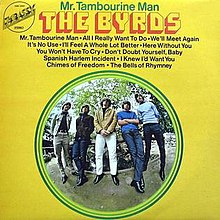
Back Mr. Tambourine Man (album) Czech Mr. Tambourine Man (Album) German Mr. Tambourine Man (álbum) Spanish Mr. Tambourine Man (albumi) Finnish Mr. Tambourine Man (album) French Mr. Tambourine Man Hungarian Mr. Tambourine Man (album) Italian ミスター・タンブリン・マン (バーズのアルバム) Japanese Mr. Tambourine Man (음반) Korean Mr. Tambourine Man (album) Dutch
| Mr. Tambourine Man | ||||
|---|---|---|---|---|
 | ||||
| Studio album by | ||||
| Released | June 21, 1965 | |||
| Recorded | January 20, March 8 – April 22, 1965 | |||
| Studio | Columbia, Hollywood | |||
| Genre | ||||
| Length | 31:35 | |||
| Label | Columbia | |||
| Producer | Terry Melcher | |||
| The Byrds chronology | ||||
| ||||
| Singles from Mr. Tambourine Man | ||||
| ||||
| Alternate cover | ||||
 Cover of the 1974 Embassy Records reissue[nb 1] | ||||
Mr. Tambourine Man is the debut studio album by the American rock band the Byrds, released on June 21, 1965, by Columbia Records.[1] The album is characterized by the Byrds' signature sound of Jim McGuinn's[nb 2] 12-string Rickenbacker guitar and the band's complex harmony singing.[2] The material on the album mostly consists of cover versions of folk songs, primarily composed by Bob Dylan, and originals written or co-written by singer Gene Clark.[3] Along with the Dylan-penned single of the same name, Mr. Tambourine Man established the band as an internationally successful act[4] and is widely regarded by critics as representing the first effective American challenge to the chart dominance of the Beatles and other British Invasion bands during the mid-1960s.[3][5]
The album was also influential in popularizing the musical subgenre known as folk rock, by melding intelligent lyrical content with electric guitars and a rock backbeat.[4][2] The term "folk rock" was first coined by the American music press to describe the Byrds' sound in mid-1965, around the same time that the Mr. Tambourine Man album was released.[6] The band's hybrid of a British Invasion beat, jangly guitar playing, and poetic or socially conscious lyrics influenced a number of acts in the mid-1960s and has also been influential on successive generations of musicians.[3][7][8]
The album peaked at number 6 on the Billboard Top LPs chart and number 7 on the UK Albums Chart. It is the band's most successful album on either chart.[9][10] The "Mr. Tambourine Man" single was released ahead of the album in April 1965 and reached number one on the Billboard Hot 100 and the UK Singles Chart.[10][11] A second single, "All I Really Want to Do", also a Dylan cover, was moderately successful in the U.S., but fared better in the UK, where it reached the top ten.[10][11]
Cite error: There are <ref group=nb> tags on this page, but the references will not show without a {{reflist|group=nb}} template (see the help page).
- ^ Rogan, Johnny (1998). The Byrds: Timeless Flight Revisited (2nd ed.). Rogan House. p. 545. ISBN 0-9529540-1-X.
- ^ a b Unterberger, Richie. "Mr. Tambourine Man album review". AllMusic. Rovi Corp. Retrieved 2009-09-21.
- ^ a b c Unterberger, Richie. "The Byrds Biography". AllMusic. Rovi Corp. Retrieved 2009-11-02.
- ^ a b Rogan, Johnny (1996). Mr. Tambourine Man (CD booklet). The Byrds. New York City: Columbia/Legacy. pp. 11–15.
- ^ Fricke, David (1996). "The Chimes of Freedom". Mr. Tambourine Man (CD booklet). The Byrds. New York City: Columbia/Legacy. pp. 7–9.
- ^ Rogan, Johnny (1998). The Byrds: Timeless Flight Revisited (2nd ed.). Rogan House. pp. 81–87. ISBN 0-9529540-1-X.
- ^ Cite error: The named reference
folkrockwas invoked but never defined (see the help page). - ^ Levith, Will (21 May 2013). "10 Acts That Owe The Byrds A Round". Diffuser.fm. Townsquare Media. Retrieved 2017-11-16.
- ^ Whitburn, Joel (2002). Top Pop Albums 1955-2001. Record Research Inc. p. 121. ISBN 0-89820-147-0.
- ^ a b c Brown, Tony (2000). The Complete Book Of The British Charts. London: Omnibus Press. p. 130. ISBN 0-7119-7670-8.
- ^ a b Whitburn, Joel (2008). Top Pop Singles 1955-2006. Record Research Inc. p. 130. ISBN 978-0-89820-172-7.